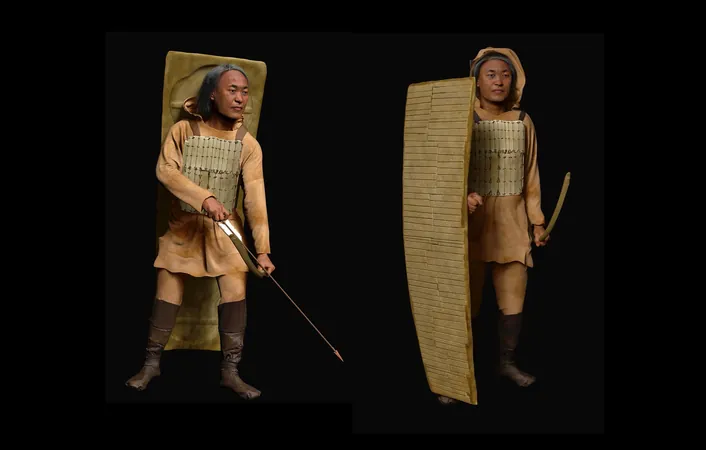
Unveiling the Past: The Face of a 4,000-Year-Old Siberian Warrior Finally Revealed!
2025-04-07
Author: Jacques
Unveiling the Past: The Face of a 4,000-Year-Old Siberian Warrior Finally Revealed!
In the summer of 2004, an extraordinary discovery took place in the remote Kerdugen area of Russia's Sakha Republic. What began as a routine archaeological survey by seasoned digger Alexander Stepanov quickly escalated into one of the most significant prehistoric finds of the region. Just a few centimeters beneath the surface, Stepanov uncovered a series of bone plates that hinted at a burial unlike any other.
Over the decades, researchers unraveled the mystery of an ancient warrior buried in the permafrost, surrounded by elaborate armor crafted from more than 100 bone plates. This enigmatic figure, who lived approximately 4,000 years ago during the late Stone Age, has now been given a face through cutting-edge 3D modeling and facial reconstruction techniques.
The Life of a Late Neolithic Warrior
Experts from the North-Eastern Federal University (NEFU) in Yakutsk have meticulously reconstructed the visage and gear of this ancient warrior, showcasing the results in NEFU’s Museum of Archaeology and Ethnography as part of the innovative project "Face to Face with the Past." Utilizing advanced digital scanning technology, the researchers recreated both the warrior's appearance and his weapons, providing a vibrant connection to a bygone era.
The warrior's tomb is particularly intriguing as it was not an ordinary grave. It featured a shield made from the bones of an Altai wapiti, alongside various bone weapons that reveal the warrior's status in life. Arrowheads embedded in the shield’s plates suggest that this individual was no stranger to conflict. His skeletal remains reflect a life of hardship, showing signs of healed injuries and robust muscular development indicative of a skilled archer.
Liliya Alekseeva, the museum's director and project co-leader, emphasizes the historic significance of the findings: “He could have been a warrior-archer... a true ‘dog of war’.”
Cultural Insights From the Grave
Radiocarbon dating places the burial at around 3,800 years ago, linking the warrior to the Ymyyakhtakh culture—a nomadic society that thrived in a harsh Arctic climate long before cities and agriculture emerged in the region. Despite standing only 5 feet 5 inches tall, the individual was evidently a figure of high status who died between the ages of 40 and 50, a notable age for that time.
Adding to the grave’s intrigue are fragments of a second human skeleton found nearby. Archaeologists suspect this could indicate a ritual sacrifice, a practice that has been suggested in various ancient Siberian contexts, perhaps reflecting the community’s spirituality or beliefs about the afterlife.
Interestingly, researchers found that a fire had been lit directly beneath the warrior’s skull—a symbolic gesture believed to signify the passage of the soul to the afterlife. Such practices highlight the importance of fire in many ancient cultures, often serving both spiritual purposes and practical needs for cleansing the burial site.
A Journey Through Time
The preservation of the warrior's burial was remarkably good, largely due to the permafrost of the region, but also thanks to the meticulous care taken in the burial itself. The artifacts, including the shield and armor, have been reconstructed using advanced photogrammetry techniques that compile hundreds of digital images into lifelike representations, bridging contemporary technology with ancient history.
Now, as museum visitors stand before the recreated bust of this warrior, they experience a hauntingly intimate encounter with a man who lived four millennia ago. With a strong jaw and weathered features that echo those of modern Arctic Siberians, his gaze draws the onlooker into the depths of history, reminding us of the complex narratives that have shaped human existence through the ages.
In a world eager to uncover its historical secrets, this resurrected warrior serves as a powerful reminder of the lives and stories that have laid buried for centuries, waiting to be rediscovered and told once more.









 Brasil (PT)
Brasil (PT)
 Canada (EN)
Canada (EN)
 Chile (ES)
Chile (ES)
 Česko (CS)
Česko (CS)
 대한민국 (KO)
대한민국 (KO)
 España (ES)
España (ES)
 France (FR)
France (FR)
 Hong Kong (EN)
Hong Kong (EN)
 Italia (IT)
Italia (IT)
 日本 (JA)
日本 (JA)
 Magyarország (HU)
Magyarország (HU)
 Norge (NO)
Norge (NO)
 Polska (PL)
Polska (PL)
 Schweiz (DE)
Schweiz (DE)
 Singapore (EN)
Singapore (EN)
 Sverige (SV)
Sverige (SV)
 Suomi (FI)
Suomi (FI)
 Türkiye (TR)
Türkiye (TR)
 الإمارات العربية المتحدة (AR)
الإمارات العربية المتحدة (AR)